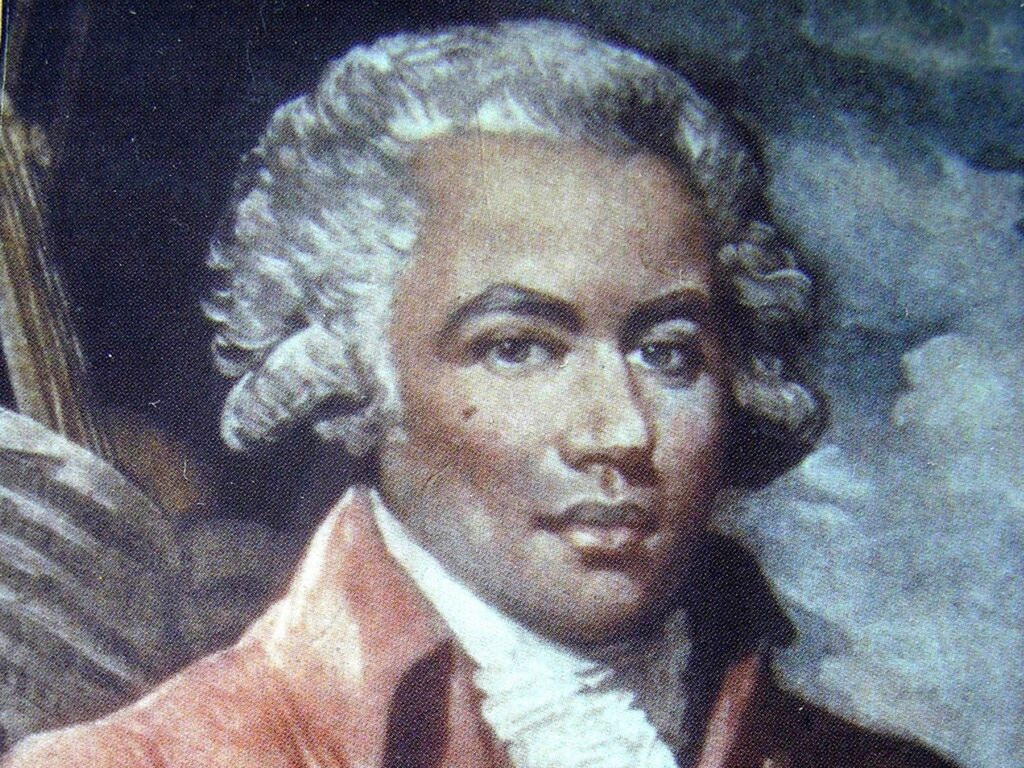
About the Composer
Joseph Bologne, Chevalier de Saint-Georges, was born in Baillif, Guadeloupe, in 1745 and died in Paris in 1799. He was not only a composer, violin virtuoso and conductor but also excelled as a fencer and athlete. His eventful life has inspired the imagination of biographers since the 19th century.
His father Georges Bologne, a planter on Guadeloupe, sent him to France to be trained by the renowned Maître d’armes Texier La Boëssiere. He graduated as one of the best fencers in Europe and was appointed Gendarme de la Garde du roi. The first steps in his musical career are comparatively obscure. The fact that both Antonio Lolli and François-Nicolas Gossec dedicated works to him leads us to assume that Saint-Georges studied with both of them. The composer and musical biographer François-Joseph Fétis (1784 – 1871), however, suggested that he was a pupil of Jean-Marie Leclair the Elder.
In the late 1760s, he joined Gossec’s Concert des amateurs, where he made his debut with two of his own violin concertos (op. 2, 1773) and instantly became a celebrated violin virtuoso. When Gossec was appointed director of the Concert spirituel in 1773, Saint-Georges took over the leadership of the Concert des amateurs. He completed his six string quartets in the same year, which, along with Gossec’s, were the first French compositions of this genre. With a series of violin concertos and his Symphonies concertantes, he finally established himself as a composer in the musical landscape of Paris. His virtuosity as a musician can be deduced from the nature of the concerts that he composed for himself and the orchestra, which featured high and highest positions on the fingerboard, great mobility of bowing and double-stop passages.
When he was suggested for a directorship at the Académie royale de musique, however, racist objections to the colour of his skin thwarted the appointment. In 1777, he wrote his first opera, “Ernestine”, for the Comédie-Italienne; one year later, he composed “La Chasse”. In 1777, Saint-Georges entered into the service of the Duke of Orléans. Employed as Lieutenant des Chasses de Pinci, he mainly took part in the artistic activities of Madame la Comtesse des Montesson. In 1781, the Concert des amateurs was discontinued due to financial straits. Shortly afterwards, it was replaced by the Concert de La Loge olympique which performed at an equally high artistic standard, again headed by Saint-Georges. Following the death of the Duke of Orléans in 1785, Saint-Georges traveled to England, where he took part in a series of spectacular fencing competitions. After his return to Paris, he worked for the new Duke of Orléans, who was well-known for his revolutionary mindset. During the French Revolution, he served as a colonel in the Légion Saint-Georges, the first European regiment that consisted entirely of Black soldiers. In 1792, he joined the Garde nationale in the rank of captain. In the same year, he was appointed colonel and brigadier general of the Légion nationales des américains et du Midi, which he had been vital in organising. Late in 1793, Saint-George fell victim to the terreurs and was sentenced to 18 months of military imprisonment. In 1795, he traveled to San Domingo to join an anti-Spanish revolt. In 1797, he returned to Paris, where he conducted the concerts of the Cercle de l’harmonie in an amateur capacity until his death in 1799.
As director of both the Concert des amateurs and the Société de la Loge olympique, Saint-Georges made a vital contribution to the artistic standard of these orchestras and he can today be seen as the first French violin virtuoso. Between 1775 and 1785, his compositions were of crucial relevance for the two main genres of French instrumental music, Symphonie concertante and solo concert. Their development went hand in hand with a rapid boom of the concert scene in Paris.
[Biographical information from the Berliner Festspiele]
Sinfonia in D
About the Work
Performance Material
Performance materials are available for purchase:
https://www.lucksmusic.com/CatalogEdu.aspx?Detail=Y&ItemCode=38061
Recording
Sinfonia in G
About the Work
Performance Materials
Performance materials are available for rental:
http://peermusicclassical.com/classical-us-catalog/393/version/347
Recording